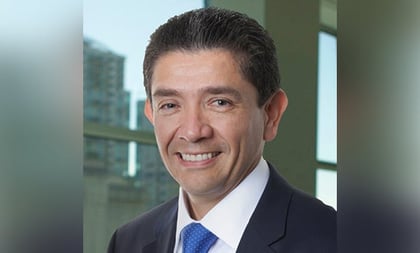The handwriting’s on the wall — writ large, Aguilar says: The bull market’s end will thoroughly transform the investing landscape, one marked by higher interest rates, higher inflation and high volatility.
That means clients must weigh whether or not they can handle a possible big slide in stocks. Diversifying into areas that offer protection and should perform well in the future is a wise move, Aguilar stresses. He has been with the Schwab division — a maker of low-cost foundational products for individual investors and institutions — since 2011.
Clients may not be as resistant to repositioning as advisors assume, since investor sentiment has already shifted away from euphoria, according to Aguilar, a financial services veteran of more than 20 years. He is responsible for CSIM’s equity and asset allocation mutual funds, ETFs and separately managed accounts. Previously, he was with Financial Engines, Lehman Brothers (when “it was hip,” he notes) and Merrill Lynch, among other firms.
(Related: Growing Chorus on Wall Street Says End of Bull Market Is Near)
ThinkAdvisor recently held a phone interview with the San Francisco-based Aguilar, who earned his doctorate at Duke University, where he was a Fulbright scholar. Against a background of rising interest rates, our conversation included his forecast on market sector winners and losers: Consumer discretionary is in, for example; bond proxies are out. Here are highlights:
THINKADVISOR: You write that the very long bull market is in its final phase. What does that mean to investors?
OMAR AGUILAR: They need to be aware that we’ll be going into a completely different phase, where interest rates and inflation will be higher, and economic growth will be lower. The era of free money is over. Liquidity will be less. Investors need to be more conscious of their risk appetite.
When will these changes occur?
The last phase of the bull market cycle is clearly evolving. It doesn’t necessarily end this year; it could last another year or two. What we know for sure is that interest rates will continue to rise based on the Fed’s plan. We see volatility changes already, and some sector leadership movements are evident. But there are a lot of unknowns, like the situation with tariffs and the tax cuts of last year, [the effects of which] aren’t yet in the economy.
How else will things be different?
There will be normal swings in volatility, which we haven’t seen in the last five years. There will be more emphasis on earnings and fundamentals. Changes that occur will be less related to monetary policy because the Fed usually takes a back seat in this type of environment. The wage growth we’ve seen will go away.
In view of this changing picture, should investors change course?
They need to be thinking about their risk profile and rebalancing portfolios: How to reposition them to diversify into other asset classes because of the volatility that will pick up going forward.
How eager will they be to rebalance?
People have enjoyed a nine-year bull market in equities, and they like to see winners stay winners. But we know from history that winners don’t stay winners forever.
Since a sentiment shift is taking place, so you write, maybe investors will be more willing to rebalance.
In 2017, people were euphoric about the equity market. But that market was an aberration, where we had zero volatility and amazing price performance. It will be very hard to replicate that.
In what way has sentiment changed?
Going into this year, it’s shifted to reality; for example, higher interest rates, a pickup in inflation. So while people are still optimistic and still like risky assets, they’re not as euphoric as they were last year. They’re also a little concerned about trade policies and how that might affect their investments.
Sounds like financial advisors have their work cut out!
Precisely. This is the time when financial advisors can do their best job — the most difficult one. They need to sit down with clients and evaluate their risk profiles.
Should they start right now?
Absolutely. People have seen their investments grow for nine years — so it’s hard for them to [make changes]. But do they really have the appetite and stomach to digest a downturn in equities? That’s where the advisor’s role comes in. This is the time that financial advisors need to have conversations with clients about how to diversify and go into areas where investors may not feel comfortable but that will benefit them in the future.
What sectors could be vulnerable to interest rate changes?
In the past, investors looked for yield in equities, which were better than anything you could get in fixed income with price appreciation. Now that has shifted to where investors can get yield from bonds without the volatility.
What types of equities will be most affected?
People are starting to look for yield in fixed income as opposed to equities. That’s a big headwind for bond proxies — companies with high dividends, like utilities, telecom, consumer staples, which tend to do very well when fixed income is doing well. In the environment [just described], they don’t do well.
What sectors do you think will be good performers?









 June 25, 2018 at 03:20 PM
June 25, 2018 at 03:20 PM











